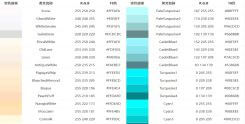- 欢迎使用千万蜘蛛池,网站外链优化,蜘蛛池引蜘蛛快速提高网站收录,收藏快捷键 CTRL + D
如何在HTML5中填充图片内容?探索最佳实践



In the world of HTML5, we have the <img> tag at our disposal for embedding images. The <img> tag is the go-to tag in HTML for inserting images, and it comes with two required attributes: src and alt. The src attribute is used to specify the URL of the image, while the alt attribute provides alternative text in case the image is unable to display.
 (Image Source: Unsplash)
(Image Source: Unsplash)Below is a simple example demonstrating how to embed images in HTML5:
<!DOCTYPE html><html><head> <title>Embedding Images in HTML5</title></head><body> <h1>Welcome to My Website</h1> <p>This is a paragraph describing something.</p> <img src="yourimageurl" alt="This is a sample image"></body></html>
Within the example above, we utilized the <img> tag to insert an image, setting the src attribute to the URL of the image you wish to insert and the alt attribute to the alternative text to display if the image cannot be shown. Make sure to replace yourimageurl with the actual URL of your image.
What are Some Other Attributes Supported by the <img> Tag?
Aside from the src and alt attributes, the <img> tag also supports some other commonly used attributes,
How Can CSS Styles Enhance the Appearance and Behavior of Images?
In addition to the basic attributes, we can further control the appearance and behavior of images using CSS styles. Here are some commonly used CSS style properties:
1. backgroundimage property: This property allows an image to be used as the background of an element, where the image can be tiled, repeated, or centered by setting the property to the image's URL.
2. opacity property: Used to specify the transparency of an image, a value between 0 and 1 where 0 denotes complete transparency and 1 signifies full opacity.
3. filter property: Enables the application of various filter effects like blur, brightness adjustments, etc., by setting different filter functions for different effects.
What New Image Elements and APIs Does HTML5 Offer?
HTML5 introduces some new image elements and APIs that include,
1. <figure and figcaption elements: These are used to create standalone image content with titles or descriptions, which is beneficial for organizing multiple related images on a webpage.
2. picture element and related media queries: This is used to select the appropriate image version based on device characteristics and screen size, aiding in optimizing the loading speed and performance of webpages on different devices.
3. Canvas API: Providing a drawing context, this API allows for drawing and manipulating graphics, images, and animations on a webpage. Through the Canvas API, more complex image processing and interactive effects can be achieved.
In conclusion, embedding images in HTML5 is a straightforward process - simply use the <img> tag and provide the necessary attributes. Furthermore, CSS styles and the new image elements and APIs offered by HTML5 can be leveraged to achieve richer image functionality and interactive effects. We hope this answer has aided in your understanding of how to embed images in HTML5.
Feel free to leave comments, follow for more insights, like if you found this helpful, and thank you for reading!
| 广告位招租-内容页尾部广告(PC) |











)
)
)


)
)
)
)
